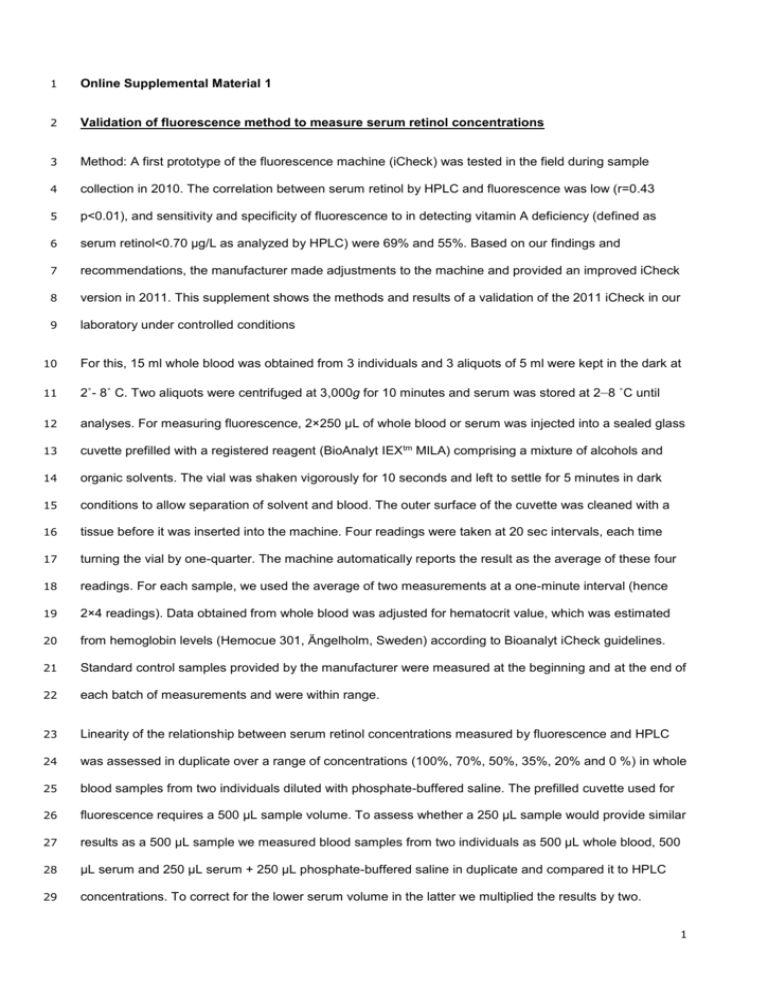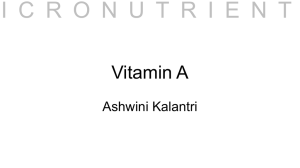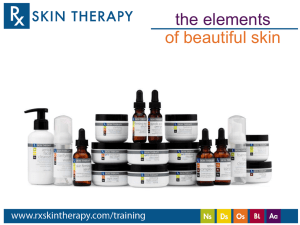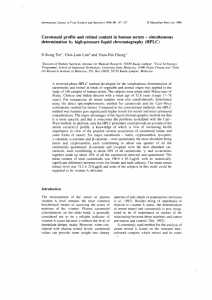Online Supplemental Material 1 Validation of fluorescence method
advertisement

1 Online Supplemental Material 1 2 Validation of fluorescence method to measure serum retinol concentrations 3 Method: A first prototype of the fluorescence machine (iCheck) was tested in the field during sample 4 collection in 2010. The correlation between serum retinol by HPLC and fluorescence was low (r=0.43 5 p<0.01), and sensitivity and specificity of fluorescence to in detecting vitamin A deficiency (defined as 6 serum retinol<0.70 μg/L as analyzed by HPLC) were 69% and 55%. Based on our findings and 7 recommendations, the manufacturer made adjustments to the machine and provided an improved iCheck 8 version in 2011. This supplement shows the methods and results of a validation of the 2011 iCheck in our 9 laboratory under controlled conditions 10 For this, 15 ml whole blood was obtained from 3 individuals and 3 aliquots of 5 ml were kept in the dark at 11 2˚- 8˚ C. Two aliquots were centrifuged at 3,000g for 10 minutes and serum was stored at 2–8 ˚C until 12 analyses. For measuring fluorescence, 2×250 µL of whole blood or serum was injected into a sealed glass 13 cuvette prefilled with a registered reagent (BioAnalyt IEX tm MILA) comprising a mixture of alcohols and 14 organic solvents. The vial was shaken vigorously for 10 seconds and left to settle for 5 minutes in dark 15 conditions to allow separation of solvent and blood. The outer surface of the cuvette was cleaned with a 16 tissue before it was inserted into the machine. Four readings were taken at 20 sec intervals, each time 17 turning the vial by one-quarter. The machine automatically reports the result as the average of these four 18 readings. For each sample, we used the average of two measurements at a one-minute interval (hence 19 2×4 readings). Data obtained from whole blood was adjusted for hematocrit value, which was estimated 20 from hemoglobin levels (Hemocue 301, Ängelholm, Sweden) according to Bioanalyt iCheck guidelines. 21 Standard control samples provided by the manufacturer were measured at the beginning and at the end of 22 each batch of measurements and were within range. 23 Linearity of the relationship between serum retinol concentrations measured by fluorescence and HPLC 24 was assessed in duplicate over a range of concentrations (100%, 70%, 50%, 35%, 20% and 0 %) in whole 25 blood samples from two individuals diluted with phosphate-buffered saline. The prefilled cuvette used for 26 fluorescence requires a 500 µL sample volume. To assess whether a 250 µL sample would provide similar 27 results as a 500 µL sample we measured blood samples from two individuals as 500 µL whole blood, 500 28 µL serum and 250 µL serum + 250 µL phosphate-buffered saline in duplicate and compared it to HPLC 29 concentrations. To correct for the lower serum volume in the latter we multiplied the results by two. 1 30 Retinol concentrations measured by fluorescence could potentially be influenced by storage time, 31 temperature of the environment, and light, which are typical factors that can vary in field settings. To 32 assess the effect of each of these factors, we first stored whole blood samples of 3 individuals in triplicate 33 for 30 minutes, 1 hour, 7 hours and 24 hours at 4 °C in dark conditions, followed by fluorescence 34 measurement. Secondly, we exposed 6 samples with varying concentrations to increasing temperatures 35 (15 °C, 20 °C, 25 °C, 30 °C and 35 ˚C) in a climate room with a constant humidity of 50%-60% and 36 artificial light. Samples and machine were allowed to adapt to the indicated temperatures for 10 minutes, 37 starting with 15 ˚C. Lastly, we exposed 6 samples with varying concentrations to three different light 38 conditions: 1) in the laboratory, at 4 meters removed from the window with artificial room lights on; 2) 39 outside at mid-morning with major overcast conditions and no visible sun; and 3) in the laboratory, close to 40 the window with artificial lights on. 41 Results: Linearity of retinol concentration measured by fluorescence and HPLC from two individuals was 42 good, with high correlation and good association (Figure 1). We found no meaningful difference between 43 results derived from whole blood samples and those from serum. At 7h and 24h of storage, concentrations 44 were reduced by 3.5% and 12%, respectively. We found no evidence that storage for 1 hour or less 45 influenced retinol concentrations. We found no evidence that temperature affected retinol concentrations 46 measured by fluorescence (Figure 2). We found a clear effect of light conditions: samples measured 47 outside and close to a window gave consistently higher retinol values than those measured inside (Figure 48 3). 49 Conclusion: Based on our results we conclude that the iCheck method provides good linearity when 50 compared to retinol by HPLC. Light has a clear influence on the measurements and therefore the method 51 should be used under controlled light conditions. 52 53 2 Serum retinol concentration, µgl/dL (fluorescense) 80 70 A 60 50 B 40 30 20 y = 1.20 x A R2 = 1.00 10 y = 0.99 x B R2 = 0.99 0 0 54 10 20 30 40 50 Serum retinol concentration, µg/dL (HPLC) 60 55 Figure 1: Linearity of retinol concentrations measured by fluorescence and HPLC in µg/dL over a dilution 56 range of whole blood from two individuals (A and B) 3 1200 Serum retinol concentration µg/dL 1000 Control Dilutions 0% 20% 35% 50% 70% 100% 800 600 400 200 0 0 57 15 25 20 Temperature C 30 35 58 Figure 2: Retinol concentrations measured by fluorescence over a temperature range of 15˚ to 30˚ in 6 different 59 dilutions Serum retinol concentration µg/dL (fluorescense) 3000 2500 2000 In a room Outside in daylight Next to a window 1500 1000 500 0 60 61 Dilution Figure 3: Retinol concentrations measured by fluorescence during three different light conditions 4 62 Online supplemental material 2 63 Elimination of diagnostic error when estimating the prevalence of vitamin A deficiency 64 Let true vitamin A status be defined by a gold standard, and let it be indicated by a diagnostic test with a binary 65 outcome. Table 1 shows the cross-tabulated data that might be obtained in a survey. 66 Table 1: Cross-tabulated data for true vitamin A status, defined by a gold standard, and diagnostic test results 67 Diagnostic test result Vitamin A deficient Total Yes No Positive A B P Negative C D Q Total R T N Capital letters in each cell indicate the number of people in that cell 68 The true and estimated prevalence of vitamin A deficiency can thus be noted as follows: 69 PrevT = R/N 70 PrevE = P/N 71 We can show that the estimated prevalence is a function of sensitivity, specificity and the true prevalence: 72 i. Sensitivity = A/R, hence A = R ·Sensitivity 73 ii. (1 ‒ Specificity) = B/T, hence B = T · (1 ‒ Specificity) 74 Thus: PrevE = P/N = (A + B)/N = [R · Sensitivity + T · (1 ‒ Specificity)]/N = (R · Sensitivity)/N + [(N-R) · (1 ‒ 75 Specificity)]/N = PrevT · Sensitivity + (1 ‒ PrevT) · (1 ‒ Specificity) 76 If Prev = PrevT = PrevE, then it can be derived that: 𝑆𝑒𝑛𝑠𝑖𝑡𝑖𝑣𝑖𝑡𝑦 = 1 + (1 − 1 ) (1 − 𝑆𝑝𝑒𝑐𝑖𝑓𝑖𝑡𝑦) 𝑃𝑟𝑒𝑣 77 5 78 Note that the association between Sensitivity and (1 ‒ Specificity) is linear, with Sensitivity = 1 when (1 ‒ 79 Specificity) = 0, and slope defined by (1 ‒ 1/Prev). This linear association is shown in Figure 5 (main text) for 80 different, arbitrarily chosen values of Prev. Thus each line represents an infinite number of paired values for 81 Sensitivity and (1 ‒ Specificity), given a true prevalence, that will allow for an unbiased estimation of that 82 prevalence. 6








